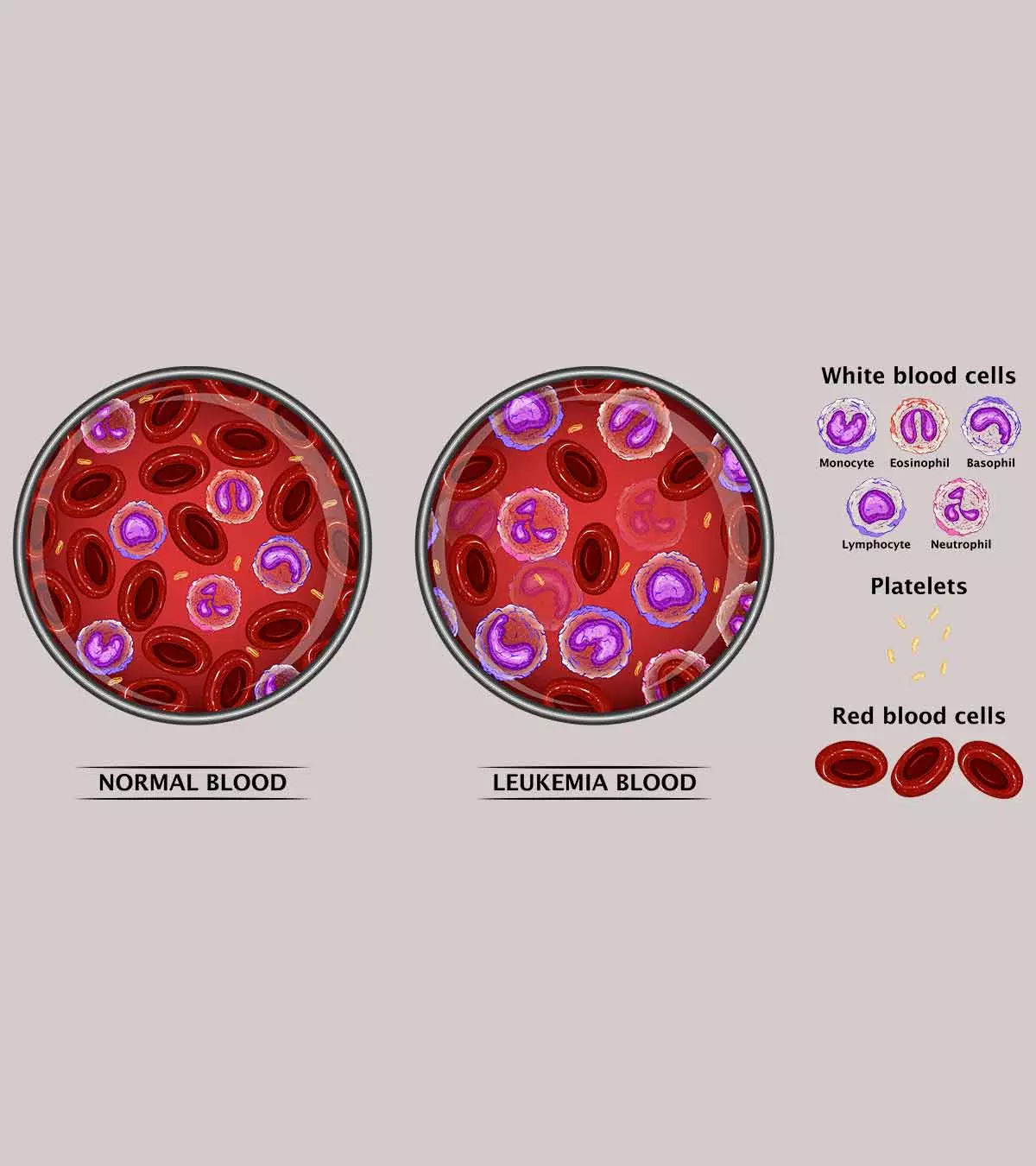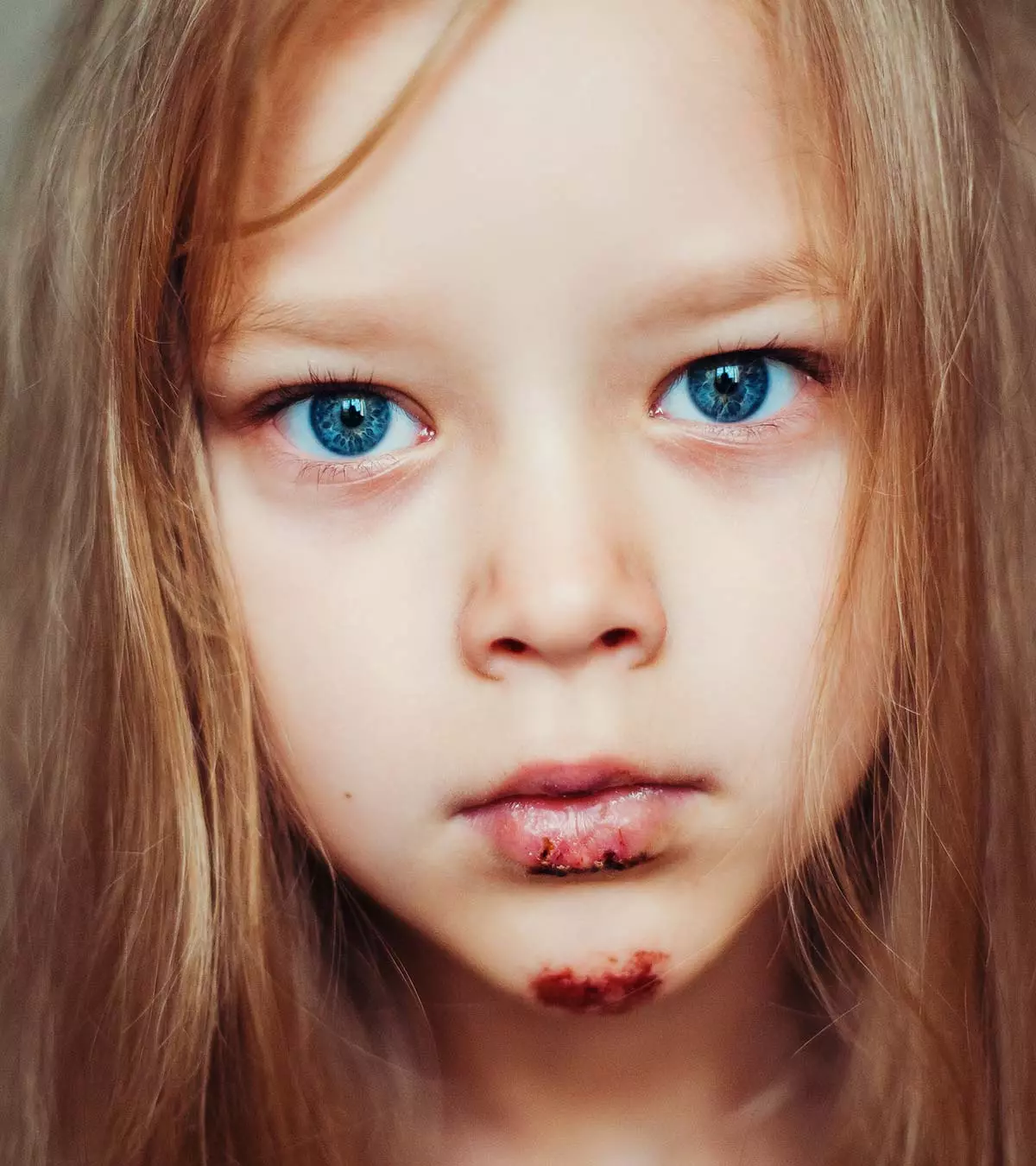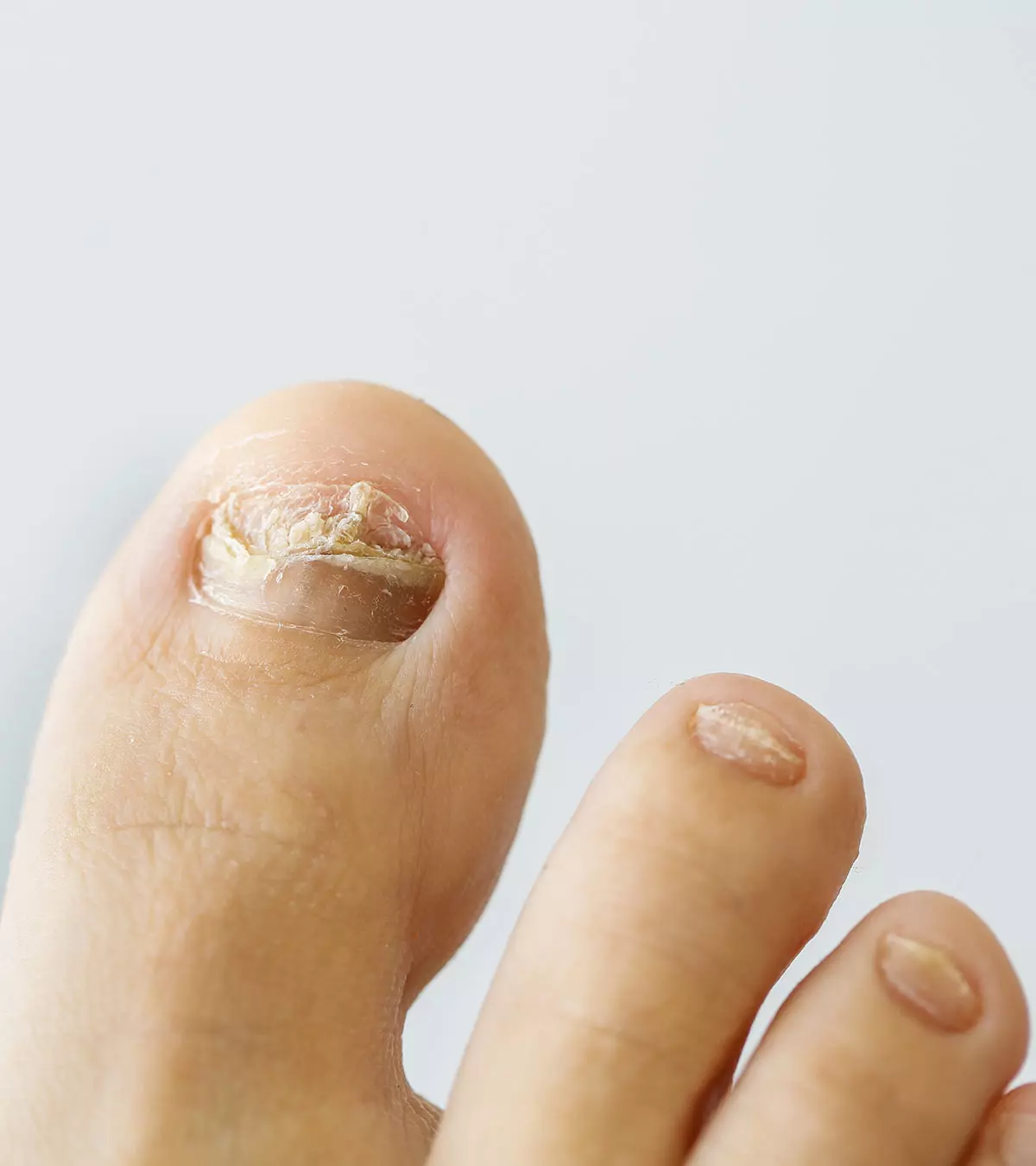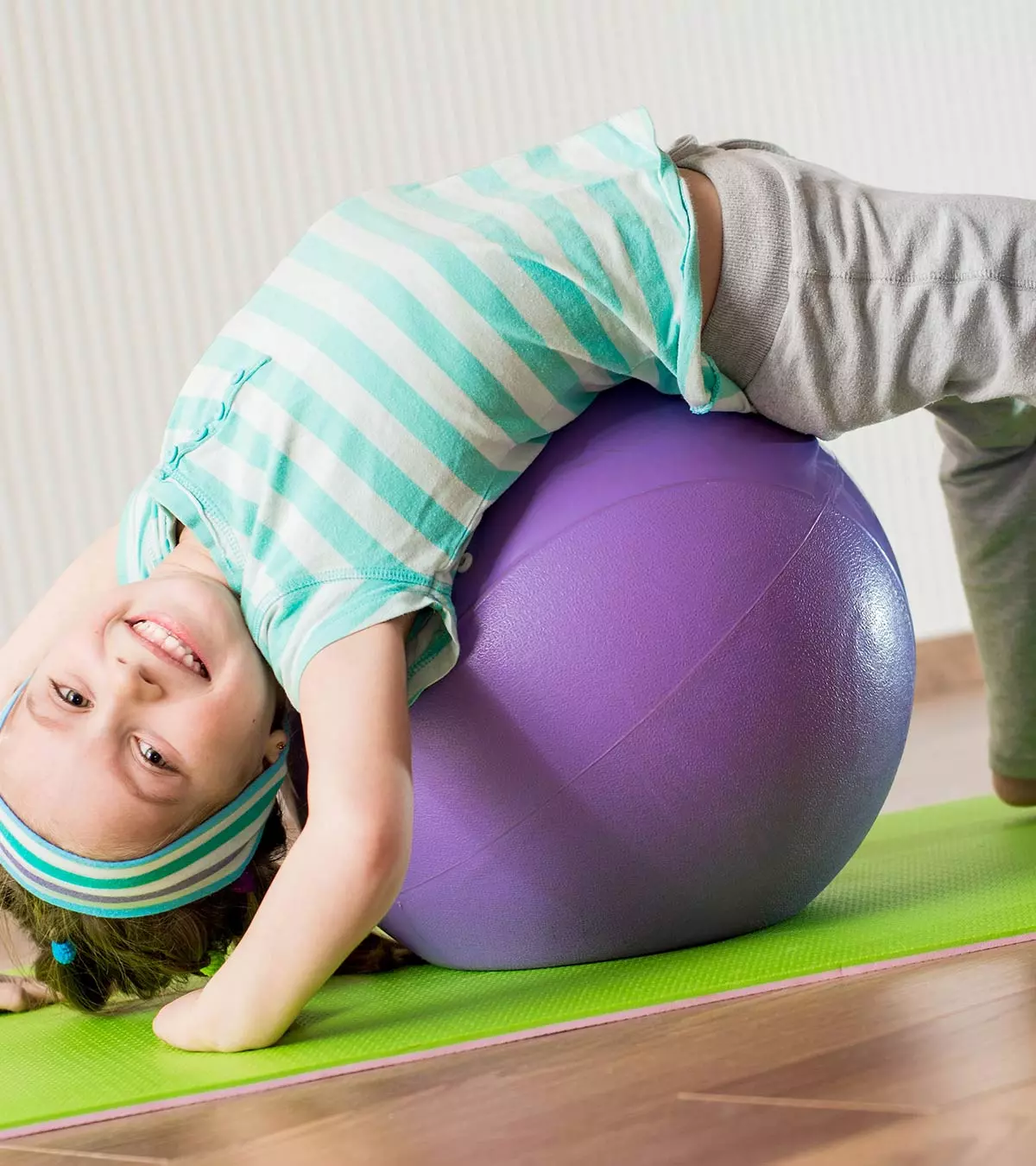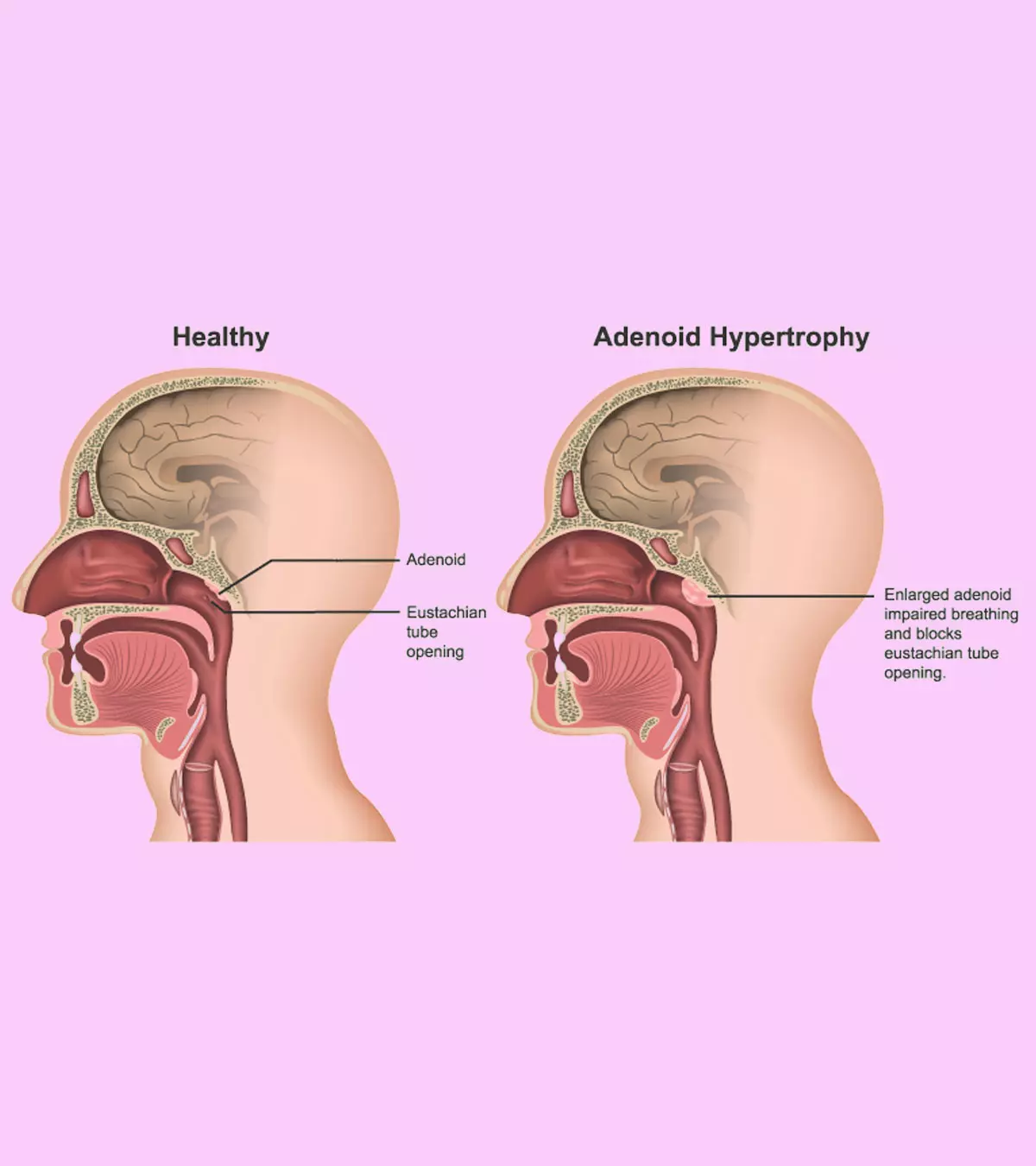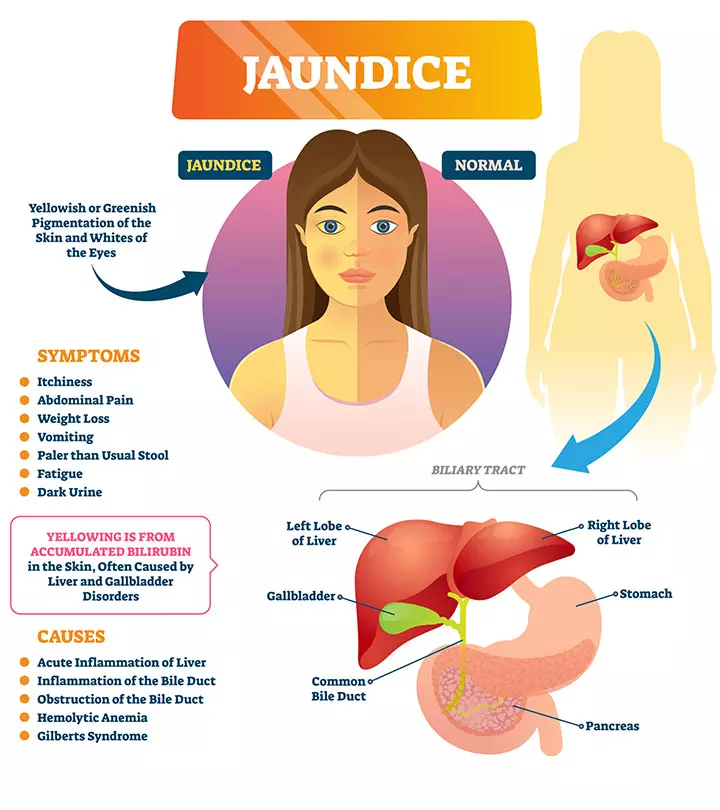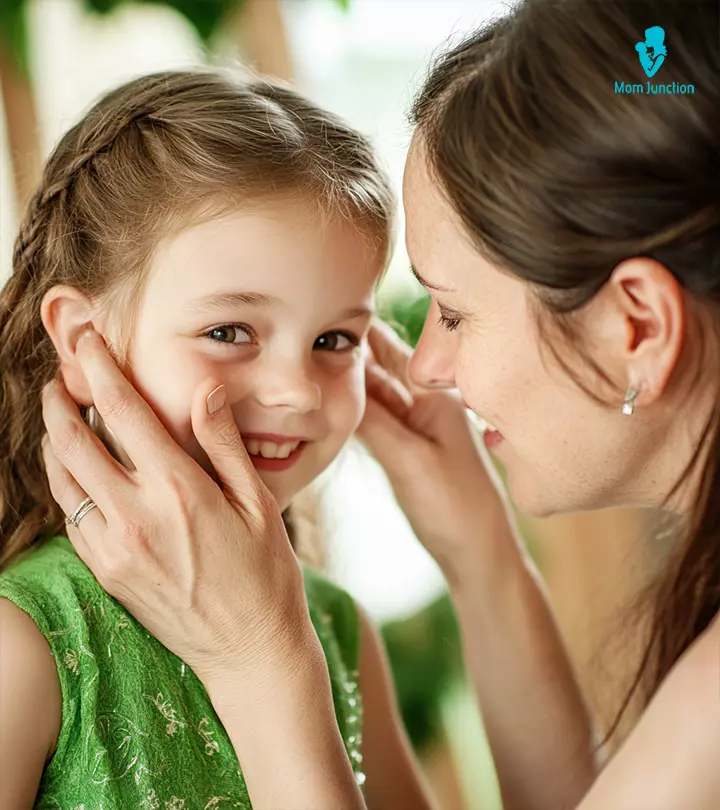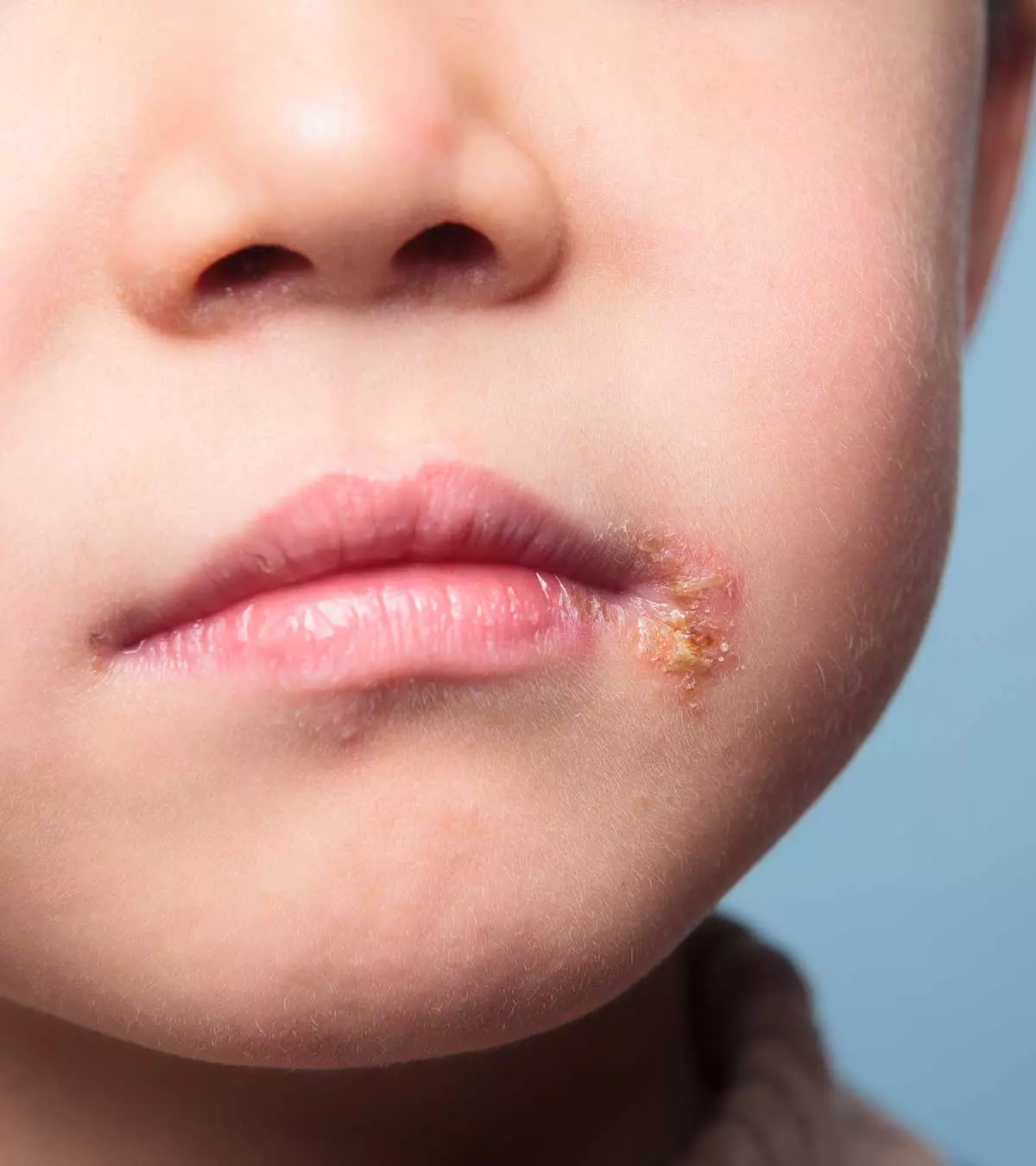
Image: iStock
Small, pus-filled blisters characterize cold sores. Also known as fever blisters, they are found more commonly on the outside of the mouth, on or around the lips, and rarely inside the mouth, on the gums, or the roof of the mouth (1) (2). Cold sores in children, also termed primary HSV, are more common between ages one and five. For most children, cold sores do not lead to any serious complications. However, children with weak immune systems or skin conditions such as eczema may experience complications. Read this post to learn more about the causes, symptoms, and preventive measures for cold sores in kids.
Key Pointers
- Cold sores, also known as primary HSV in children, are small pus-filled blisters that appear around or inside the mouth.
- They can spread through skin-to-skin contact, saliva, and sharing utensils or clothes during the two-week healing period.
- Secondary triggers such as cold weather, fever, sunlight, stress, infections, and a weak immune system can cause a flare-up of cold sores.
- Symptoms of cold sores include soreness or itchiness around the lips, irritability, drooling, pus-filled or crusted blisters, fever, sore throat, and swelling of the lymph glands and gums.
- Skin ointments, antiviral medications, and home remedies such as hot or cold compress, lemon balm leaf extract, and aloe vera gel can help manage cold sores.
What Causes Cold Sores In Children?
Cold sores can be due to a primary cause, such as a virus, or a secondary cause that triggers the dormant virus.
1. Cold sores due to primary infection
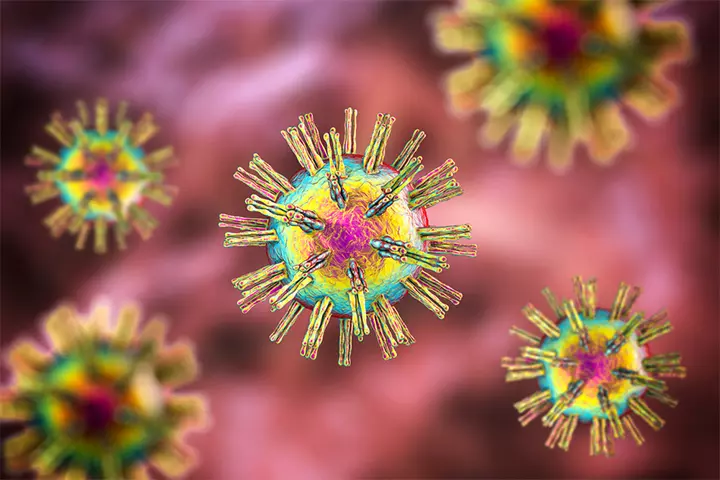
Image: Shutterstock
They are caused by a contagious virus called herpes simplex virus type-I (HSV-1), which remains contagious for six to eight days.
2. Cold sores due to secondary infection (cold sore triggers)
are among the most common reasons for cold sores. Once the child is infected with the herpes virus, the virus remains dormant in the body even after the symptoms disappear.
Some of the triggers which can cause flare-ups are (2):
- Infections
- Cold weather
- Fever
- Menstrual period
- Sunlight
- Emotional stress
- Weak immune system
This could be a reason why some children might get cold sores repeatedly.
What Does A Cold Sore Look Like?
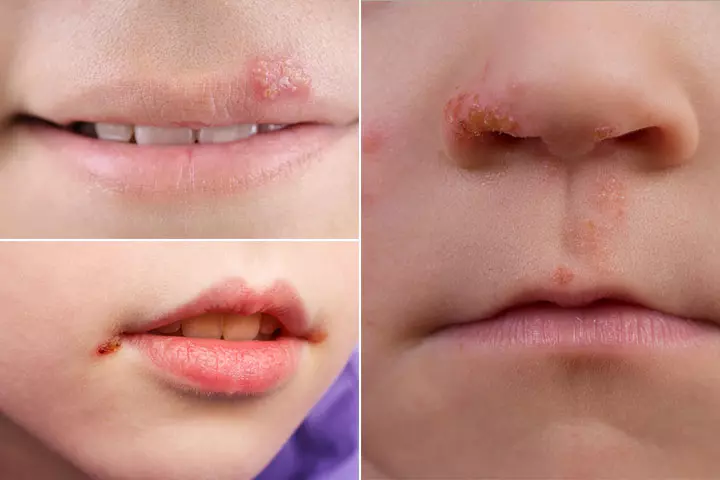
Image: Shutterstock
How Do Cold Sores Spread?
Cold sores can spread from one person to another through the virus, which can be transmitted within 24-48 hours before the sores appear on the skin (3). It gets transferred through:
- Skin-to-skin contact
- Saliva
- Touching or sharing utensils and clothes of an infected person
Usually, the blisters ooze after a few days, leaving the crust behind. It takes around a week or two for the crust to heal completely. Children who stay close to the infected people are at risk of contracting cold sores.
Unlike canker sores or mouth ulcers, these are usually found outside the mouth and can be contagious. So how can you know for sure if the child has cold sores? Read on, and we’ll tell you.
Symptoms Of Cold Sores In Children
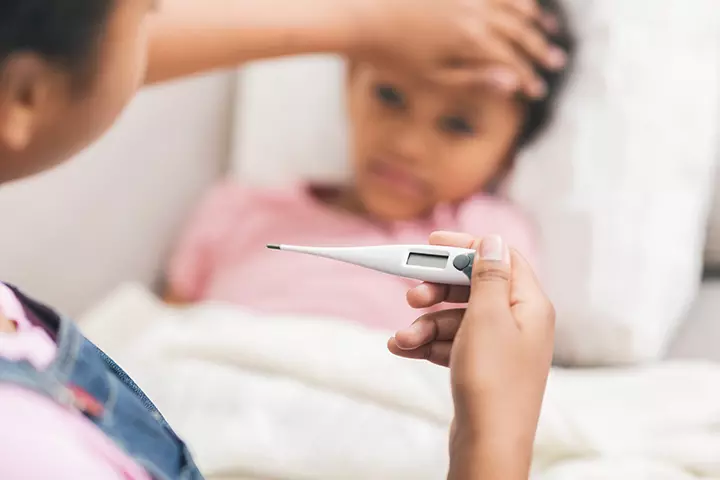
Image: IStock
Children with cold sores may show different signs, some of which could be so mild and negligible that you may not notice. The common symptoms are (3) (4):
- Soreness around the lips and mouth that lasts for three to seven days
- Irritability and drooling
- Blisters that appear on the lips and inside the mouth may discharge pus and leave a crust
- Fever
- Sore throat
- Itching and tingling sensations where the blisters are
- Swollen and tender lymph glands
- Swelling of gums
Some of these symptoms can cause discomfort and may need medical intervention. Read the next section to know when you need to seek medical advice.
When To Seek Medical Attention?
Usually, these fever blisters heal away after seven to eight days. But if you find any of the following symptoms, then take your child to the pediatrician (5).
- If the sores do not start healing after ten days
- You doubt that it might not be a cold sore.
- Your child has swollen, painful gums with multiple sores inside the mouth.
- Your child has a weakened immune system.
- If your child has repeated cold sores.
- If the cold sore shows up on the eye (6).
Based on the symptoms, the doctor will be able to diagnose the condition in the following ways.
 Caution
CautionHow Are Cold Sores Diagnosed?

Image: Shutterstock
The diagnosis involves a physical examination by the doctor. They will check for and ask about the symptoms and might suggest you get the skin scraping test and a blood test done.
A skin scraping test involves retrieval of a sample by scraping the sore gently, which is then tested to identify the virus. A blood test may be advised to check the presence of the virus in the bloodstream (7).
Once the diagnosis is confirmed, the doctor will suggest the treatment.
What Is The Treatment For Cold Sores In Children?
Cold sores usually go away on their own after seven-eight days. Though the virus cannot be entirely removed, treatment can be provided to soothe the pain caused by the sores. Usually, the sores start to heal on their own in a few days. Also, your child’s doctor might prescribe a suppressive therapy based on the frequency of recurrences.
Otherwise, the treatment includes the use of prescription antiviral medicines for cold sores, and skin ointments or cold sore creams, which can be effective if used at the first signs of the infection (4) (8). Tylenol and Motrin are effective in managing painful sores, says pediatrician Dr. Gellner (7).
In addition to the treatment, a few home care tips can help ease the pain and discomfort that the child has to deal with.
Home Care Tips To Ease Discomfort Of Cold Sores
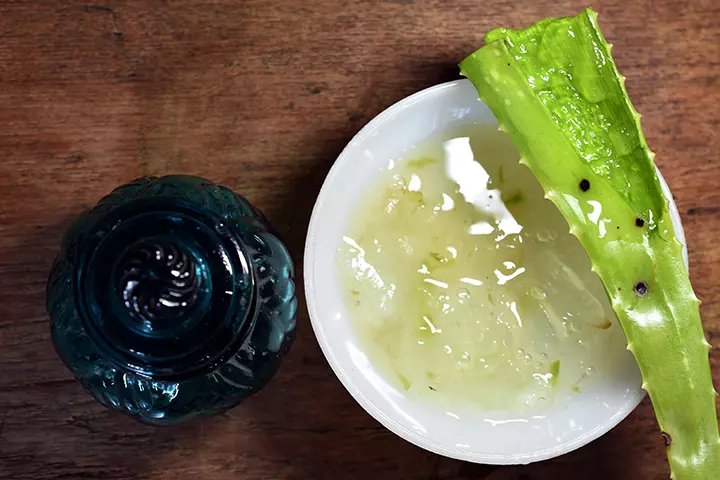
Image: IStock
Here are some tips to ease the discomfort and pain caused by the cold sores.
- Cold or warm compress: Apply ice directly on the cold sore or use a warm compress.
- Melissa leaves extracts: Lemon balm leaves are known for their antiviral properties. The dried extracts of Melissa may help reduce the herpes simplex infections. These extracts can be used to make a balm that can be applied to the affected areas (9). This treatment could be most effective if initiated early on.
- Avoid acidic food: Citrus fruits are acidic and can irritate the sores. So, avoid such foods in the child’s diet.
- Icy treats: Chilled food items like smoothies can have a soothing effect on the sores and may also help keep the lips hydrated.
- Aloe vera gel: According to a study, aloe vera gel could have inhibitory effects on the herpes simplex virus (10).
- Avoid the triggers which can flare up the cold sores.
These measures alleviate the pain and the discomfort caused by the cold sores. The infection cannot be treated entirely, but it can be prevented if you take the necessary precautions.
Can You Prevent Cold Sores?
As it is difficult to remove the virus from the body, you can always take precautions that might prevent your child from contracting the infection (4) (7):
- Avoid contact with children or adults who have the infection.
- Prevent your child from scratching the sore as it may cause the pus to leak and spread to other parts of the body, like the fingers and eyes.
- Do not let the child share clothes or utensils with someone who is infected by the virus. Also, clean the utensils and clothes used by the child separately, using hot water.
- Do not send the child to school if there is an outbreak of cold sores.
- Prevent skin to skin contact with a person who has sores.
- Apply some balm, cream, or sunscreen on the child’s skin before they step out into the sun. This will prevent any skin irritation, which can trigger cold sores.
- Ensure that they remain physically active, get enough sleep, and eat well-balanced meals to boost the child’s immunity.
Frequently Asked Questions
1. What are the stages of a cold sore?
The stages of cold sores in kids include (11) (12):
- Initiation of symptoms such as tingling, itching, and irritation on the lips and mouth
- Progression of symptoms occurs wherein a small blister or group of blisters on the lips and mouth develops and gets bigger
- Rupture of blisters that begin to crust over
- Formation of scabs as a process of healing that are often itchy, may crack open and can bleed
- The resolution may take around seven to 10 days.
2. What is the most painful stage of a cold sore?
The most painful stage of a cold sore is when the blisters of cold sores rupture and scabs are formed (12).
3. Does toothpaste help relieve cold sores in kids?
Yes. The Wound Care Society states that the active ingredient of toothpaste, known as Sodium Lauryl Sulfate (SLS), can prevent the formation of blisters during a viral invasion, and so it can be used as a home remedy for cold sores (13).
4. Can cold sores go away in three days?
If the cold sores have appeared for the first time, they may take up to three weeks to heal. However, when they return, they may begin to heal in a week, even without medicines. The healing may be faster if antiviral medications are started three to four days before blister formation (14).
You may consider seeing a pediatrician if you notice any small, pus-filled blisters around your child’s lips or inside their mouths. These cold sores are transmissible and can pass from one person to another. They are more common in children between the ages of one and five. If you suspect your child has cold sores or is diagnosed with them, take all necessary measures to curb the spread by keeping them indoors and away from the school. Lastly, proper stress management to overcome the illness goes a long way in enabling a healthier and positive outlook on recovery.
Infographic: Home Care Tips To Ease Discomfort Of Cold Sores
Cold sores are often self-resolving and may not need medical treatment in children. If your child is experiencing mild sores, you may try relieving their discomfort by following some simple home care measures discussed in this infographic. Illustration: Momjunction Design Team
Illustration: Cold Sores (Fever Blisters) In Kids: Causes And Treatment
_in_kids_causes_and_treatment_illustration.jpg.webp)
Image: Dalle E/MomJunction Design Team
In this informative video, discover practical tips and remedies to assist your toddler in dealing with a cold sore and promoting their comfort and recovery.
References
- Cold Sores; MedlinePlus; US National Library of Science
https://medlineplus.gov/coldsores.html - Cold Sores in Children; Boys Town Pediatrics
https://www.boystownpediatrics.org/knowledge-center/cold-sores-children - Herpes Simplex Virus (Cold Sores) in Children; University of Rochester Medical Center
https://www.urmc.rochester.edu/encyclopedia/content?contenttypeid=90&&contentid=P02518 - Cold Sores; Regents of the University of Michigan
https://www.mottchildren.org/health-library/hw31977 - Cold Sores; National Health Service
https://www.nhs.uk/conditions/cold-sores/ - How To Treat Your Child’s Cold Sore; University Of Utah
https://healthcare.utah.edu/the-scope/shows.php?shows=0_htfvsk14 - Herpes Simplex Virus (Cold Sores) in Children; University Hospitals
https://www.uhhospitals.org/health-information/health-and-wellness-library/article/diseases-and-conditions—pediatrics/herpes-simplex-virus-cold-sores-in-children - SH James and RJ Whitley; Treatment of Herpes Simplex Virus Infections in Pediatric Patients: Current Status and Future Needs; NCBI(2013)
https://www.ncbi.nlm.nih.gov/pubmed/?term=Whitley%20R%5BAuthor%5D&&cauthor=true&&cauthor_uid=20881952 - Local therapy of herpes simplex with dried extract from Melissa officinalis; ScienceDirect
https://www.sciencedirect.com/science/article/pii/S094471131180019X - Rezazadeh F Moshaverinia M Motamedifar M Alyaseri M; Assessment of Anti HSV-1 Activity of Aloe Vera Gel Extract: an In Vitro Study; NCBI
https://www.ncbi.nlm.nih.gov/pubmed/26966709 - Is it a cold sore or a canker sore?
https://uhs.umich.edu/coldcankersores - Cold sores: Overview; NCBI
https://www.ncbi.nlm.nih.gov/books/NBK525782/ - Does salt and toothpaste help cold sores?
http://woundcaresociety.org/cgi-sys/suspendedpage.cgi - Cold Sores
https://www.hopkinsmedicine.org/health/conditions-and-diseases/cold-sores#:~:text=Cold%20sores%20are%20small%20blisters - Cold Sores in Children: About the Herpes Simplex Virus
https://www.healthychildren.org/English/health-issues/conditions/skin/Pages/Herpes-Simplex-Virus-Cold-Sores.aspx
Community Experiences
Join the conversation and become a part of our nurturing community! Share your stories, experiences, and insights to connect with fellow parents.
Read full bio of Dr. K. Harish Kumar
Read full bio of Dr. Ritika Shah
Read full bio of Swati Patwal
Read full bio of Ghazia Shah






 Quick fact
Quick fact
